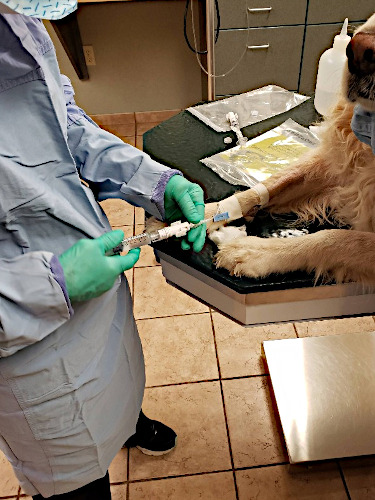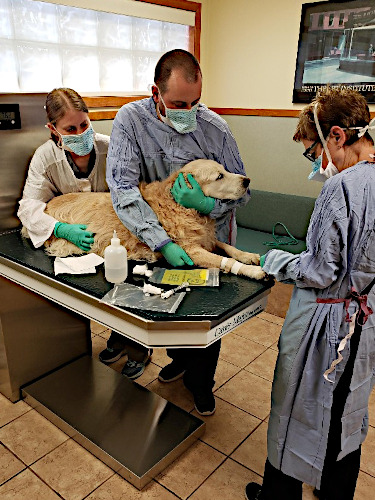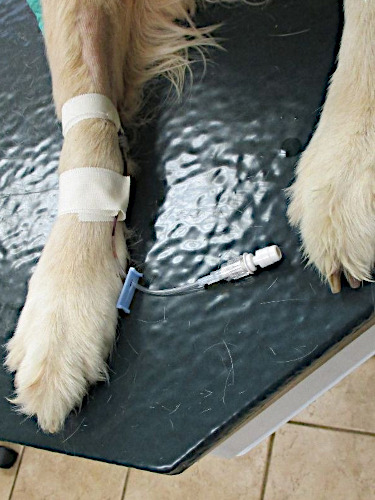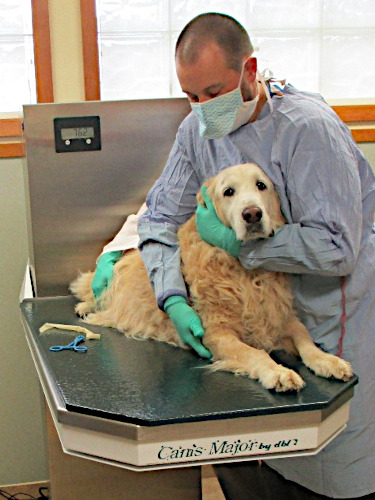Cancer has become the leading cause of death in dogs. Approximately 1 in 3 domestic dogs will develop cancer, which is the same incidence of cancer among men. Lymphoma accounts for 7-24% of all canine cancers. Lymphoma generally affects lymphoid tissues, including the lymph nodes, spleen, and bone marrow, but lymphoma can arise in virtually any tissue in the body. The gastrointestinal tract, liver, nasal passages, central nervous system, kidneys, bone, testes, and heart can be affected.
Lymphoma is classified based on stage.
-
- Stage 1 is only one lymph node affected.
- Stage 2 is multiple lymph nodes on one side of the body.
- Stage 3 is multiple lymph nodes on both sides of the body.
- Stage 4 Involves the liver and/or the spleen.
- Stage 5 is disease within the bone marrow or abnormal locations (eyes, CNS, bone, lungs, etc.).
Stage 2-4 typically have the same prognosis, while stage 1 dogs may do better, and stage 5 dogs tend not to do as well long term. Lymphoma is also sub-staged as either substage a or b.
Substage a dogs are otherwise healthy with normal appetite, while substage b dogs present sick due to the lymphoma. This has prognostic significance as substage a dogs tend to do better than substage b dogs.
Lymphoma may also be classified according to the type of lymphocytes that have become malignant; that is as either B-cell or T-celI or in rare cases mixed or gamma/delta cell or null cell. The differentiation has prognostic value, with B-cell lymphomas responding better to chemotherapy. However, the treatment remains the same for
both types.
Checking lymph nodes is part of every health exam at Neumeister Animal Hospital. If Dr. Neumeister finds certain symptoms, such as but not limited to enlarged lymph nodes, she will arrange for a consultation with the oncology department of the University of Wisconsin or other oncology specialists. Once a treatment plan has been established, and if it is more convenient for the client, Dr. Neumeister can work together with the oncologists by performing the needed periodic blood tests and the administration of chemotherapy drugs.
“The CHOP protocol” is the most successful standard treatment for lymphoma. It is a combination of three chemotherapy agents and a steroid, prednisone. With treatment with CHOP chemotherapy, it is expected that 90% of patients will go into clinical remission, meaning that lymph nodes return to normal size. The median survival time for dogs treated with CHOP chemotherapy is approximately 1 year, with approximately 10-20% of dogs alive at 2 years. Negative prognostic factors that would decrease this anticipated survival include a T cell phenotype and signs of systemic illness at diagnosis.
The photos below show IV chemotherapy administration by Dr. Neumeister as part of “The CHOP protocol”.
Restraining patient before administration View of paws before chemo administration
Preparing Chemotherapy Medicines
Administration of medication
It is important to be careful when handling chemotherapeutic drugs. As you can see in the above photos: everyone is wearing gloves, procedure masks, lab coats and/or gowns. After using the gloves, empty medication containers, as well as any sharps are disposed of in appropriate bio-hazard containers.
For more information about handling chemotherapy medications at home click on the link “Safe handling of Chemotherapy at home“
Sources:
UW Veterinary Care – University of Wisconsin – Madison
https://uwveterinarycare.wisc.edu/pet-cancer-treatment-therapy-options
https://en.wikipedia.org/wiki/Cancer_in_dogs
https://www.petmd.com/dog/general-health/chemotherapy-dogs-everything-you-need-know






